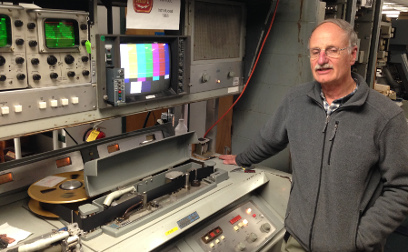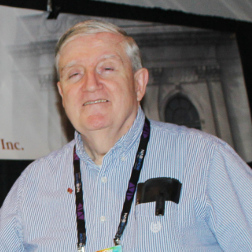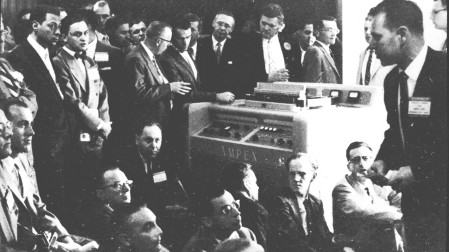Museum Seeks Aid in Getting Vintage VTR to NAB Show
ARLINGTON, VA.—During my first year with TV TechnologyI had the pleasure of writing a story commemorating the 50th anniversary of the introduction of the videotape recorder at what is now the NAB Show. It’s hard to believe that we’ve traveled around the sun another 10 times since I was interviewing members of the Ampex team that created the machine and scrounging up photographs to go with the story. Time moves way too fast when you’re having fun.

MBT Museum co-founder Tom Sprague puts the six-decade Ampex VTR through its paces.
THE VR-1000 LIVES ON!
I had some more VTR-related fun a few weeks ago in traveling to Woonsocket, R.I. and spending an afternoon at the Museum of Broadcast Technology there. In case you’re not familiar with this organization, it has to be the world’s largest repository and display space exclusively devoted to professional broadcast equipment. There are scores of TV cameras, some dating back to the 1940s; a tube-type sync generator filling a full rack, and videotape machines—many, many tape machines.
One of the crown jewels of this assemblage of broadcast heavy metal is an Ampex VR-1000, the company’s first production VTR. It went into production just months after a prototype was unveiled to a stunned audience comprised of CBS TV-affiliate station engineers. To fully appreciate my usage of the adjective “stunned,” you would have had to have been there. (I wasn’t, being only nine years old at the time, but in speaking with some of those who were it was truly an historical occasion, with applause, whistling, back slapping, climbing on chairs, and the like which lasted for upwards of 10 minutes.) Several companies and organizations had been working on developing a videotape recorder, but Ampex was the first to arrive in that new world, instantly stopping all other R&D work and moving television into a totally new direction.
No, the VR-1000 in Woonsocket is not serial number 00001 or even a machine close to that seminal unit. The first machine shipped went to CBS, and after nearly 60 years its whereabouts is unknown, if it exists at all. However, the MBT machine (it’s a VR-1000B) is one of the very, very few surviving 1000’s that is still completely operational, having been restored to functionality by a lot of TLC from Museum volunteers. It still has all of its vacuum tube signal and servo circuitry intact (two racks full) and as an added “plum,” has been equipped with time base correction and chroma stabilizing units, allowing it to play back recordings in color (something that the original machine couldn’t do.)
TAKING THE VTR TO LAS VEGAS FOR A BIRTHDAY CELEBRATION
In speaking with Museum volunteer Jay Ballard, I learned that some planning had taken place last year for transporting this VR-1000B to the April 2016 NAB Show as a special treat for showgoers—many of whom have never seen a VTR that uses two-inch-wide tape, requires two separate 30-Amp power feeds, includes a vacuum pump and is driven by scores of glowing vacuum tubes. Unfortunately, the plan was derailed when a funding grant request fell through.
In digging a little deeper, I spoke with one of the Museum’s founders, Tom Sprague—someone who may be familiar to NAB Show attendees, as he and the other founder, Paul Beck, have brought working examples of yesteryear broadcast technology to the show for the past several years; none as large or impressive as a VR-1000B, though. Sprague told me that the heavy, bulky and somewhat fragile machine would have to be moved by a group that specializes in transport of electronic gear; something that doesn’t come cheap.
“If the machine were to go to NAB, it would have to have special handling—something like the ‘air ride’ vans you see on the highway,” said Sprague. “The equipment racks are seven feet tall. Just getting it out of the Museum’s front door would require special handling.”
The professional video industry's #1 source for news, trends and product and tech information. Sign up below.
Due to the fragility and physical size of the great-grandad recorder, special handling would also be needed at the Las Vegas Convention Center.

Paul Beck “It could not be hand carried,” said Sprague. “It would have to he handled by union personnel there,” said Sprague, noting that while the LVCC freight handlers do a wonderful job in getting gear in and out of the halls, they are expensive. Also, as the machine requires 60-Amp electrical service, this would add to the expense.
Nevertheless, if the money could be made available for the move and setup, Sprague and Beck would be willing to let the machine make the 2,700-mile road trip, and have volunteered to head to Vegas early to make sure that it’s operational by show time.
Asked if he had any estimate of how much funding would take to make the VR-1000 available for all to see (and hear) at the NAB Show, Sprague wasn’t hesitant in naming a figure.
“All in all, we estimate that it would cost $25,000. This is more than the entire annual operating budget of the Museum.”
So, what to do?
A fallback plan is to produce a video that shows the machine in operation in its Woonsocket location.
“It would be a short tour of the machine, highlighting the new ‘advanced’ features of the ‘B’ version and would include video output taken directly from the machine’s proc amp,” said Sprague.

Jubilation over the introduction of the world’s first VTR at the 1956 Chicago NARTB (National Association of Radio and Television Broadcasters) Show
However, looking at a recording of this dinosaur VTR just doesn’t have the impact of seeing and hearing such a device operate “in person.” (Actually, there are some quad machine videos posted on YouTube, including one from the MBT.) If you’ve never been up close to a quad, you really haven’t experienced what it’s like to hear the head assembly spin up to some 14,400 RPM (that’s 240 revolutions per second), hear the tape guide “shoe” snap into place after the head revs up, and then hear the heads literally biting into the moving tape.
The only way to really experience this is to stand beside such a machine as the “play” switch is punched and then watch for the video to appear on the monitor (it takes around 10 seconds; no “instant” pictures 60 years ago). And it seems only fitting and proper that such a machine should grace the NAB Show floor on this important anniversary.
YOUR HELP IS NEEDED
Yes, upwards of $25,000 is not exactly pocket change for most of us, but when you consider what the big broadcast equipment manufacturers spend for floor space and shipping of their exhibits, this sum begins to move down towards the noise level. And what if there were multiple donors? Ten entities pledging $2,500 each would do the trick, or 25 commitments of just $1,000.
I have to ask too, if it can’t happen this time, what are the chances of getting an operational “model T” VTR to the 2026 or 2031 NAB Shows (70thor 75th anniversaries)? Not too likely, as the small cadre of engineers who can keep these things running is getting quite long in tooth, and replacement parts (such as head assemblies) are becoming more and more difficult to obtain.
This really has to happen this year if it’s going to happen at all!
The Museum is a registered 501(c)(3) non-profit organization and donations are tax-deductible. If you’d like to help send this working example of 60-year-old broadcast technology to Las Vegas, now is the time to do it. Please donate as generously as you can. Let’s see if we can’t give show attendees something to talk about for a long time. You can contact Tom Sprague at maindesk@wmbt.org.
At any rate, we’ll see you at the MBT booth in Central Hall!
